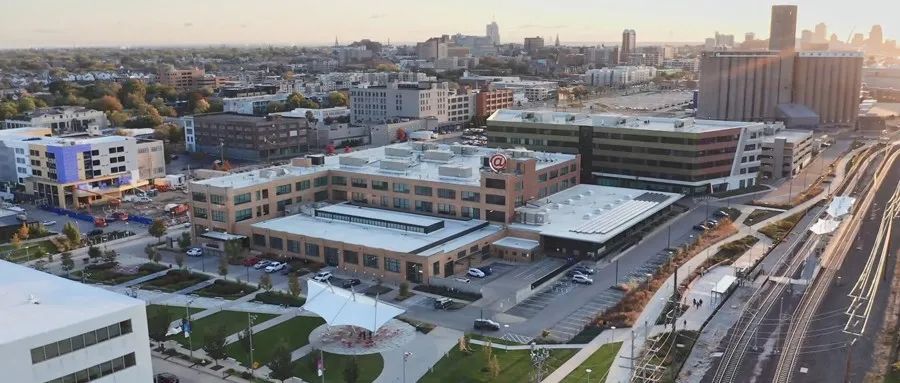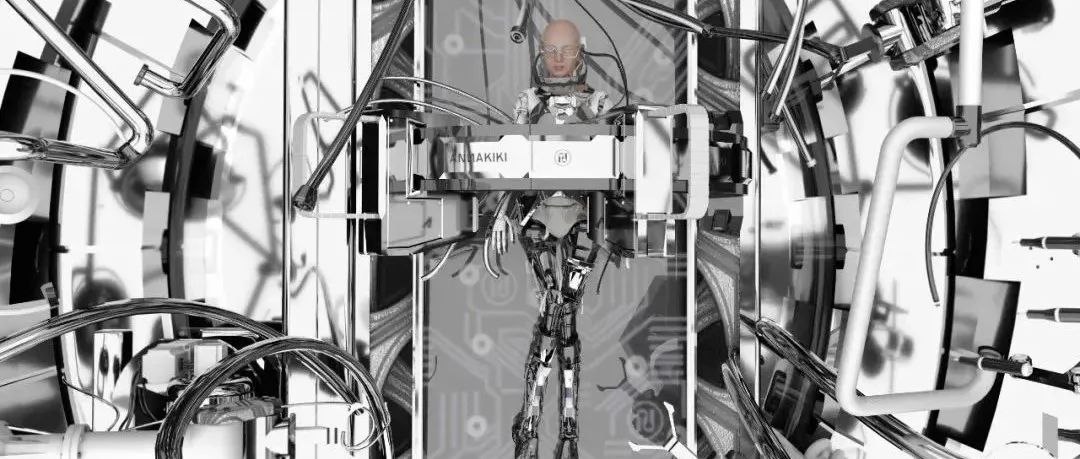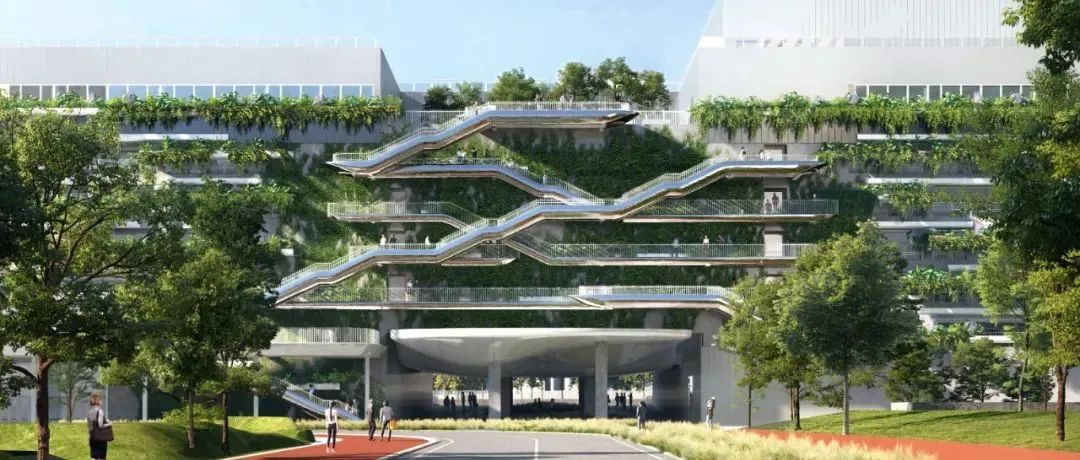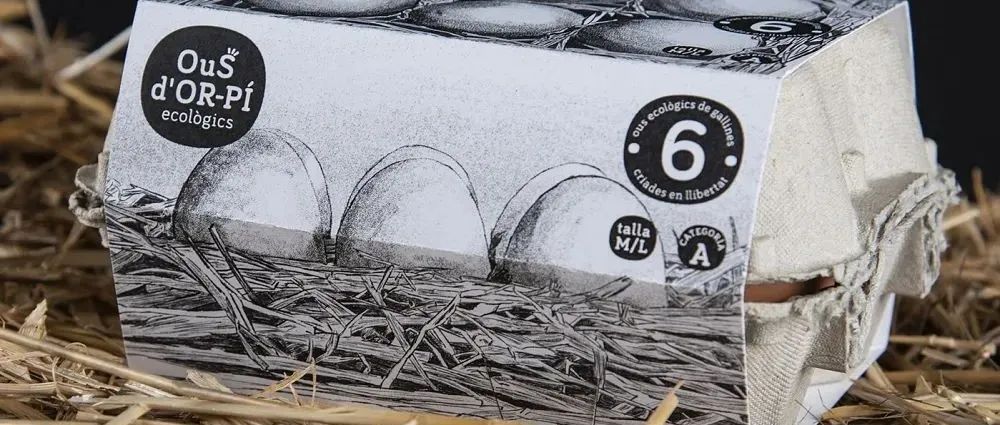Cortex科创社区是一个世界级科学创新中心,被誉为美国科创园区的典范,是目前发展最快的高科技创业社区之一。
Cortex位于圣路易斯市中心核心区以西四英里(约6.5公里)处,总占地200万平方英尺(约81公顷)。社区目前包含400多家公司以及其6,000名员工,成为了创业者、科技领域从业者、科研机构、跨国企业创新部门等的聚集地,是名副其实的学术、研发、产业、城市相结合的地区经济高价值孵化引擎。
HOK参与了Cortex大部分的建筑和室内设计。设计团队的目标是创建符合市场预期且具有“经济标志性”的设施,同时设计一个像在Cortex工作的人们一样,精明、有趣且具有创新精神的空间。
地点:美国 圣路易斯
规模:81公顷
建筑面积:185,800 平方米
公司:415个
员工:6千名
服务:建筑设计、工程、室内设计、景观设计、灯光设计、规划 + 城市设计、可持续发展设计
背 景
20多年前,圣路易斯中城南缘有一片废弃的工业用地。占地81公顷的这个工业区内,到处都是无人使用的老旧工厂建筑,让人联想到后工业城市中许多贫困社区。
后来,曾担任圣路易斯华盛顿大学校长的威廉·H·丹福思博士成立了植物与生命科学联盟,开始将圣路易斯打造成一个全国性研发中心。丹福思博士相信,基于当地机构和公司正在进行的世界级研究的势头,植物和生命科学可以成为该地区强大的经济引擎。丹福思博士和他的朋友约翰·杜宾斯基(John Dubinsky)一同访问了波士顿地区,了解麻省理工学院(MIT)是如何资助位于剑桥市(MIT所在地,紧邻波士顿市)的肯德尔广场(Kendall Square)创新区的蓬勃发展。之后,丹福思博士和杜宾斯基先生带着复制这种模式的愿景回到了圣路易斯。
之后不久,在2002年,圣路易斯的市民、机构和商界领导们进行了前所未有的合作,成立了Cortex(Center of Research Technology and Entrepreneurial Exchange,研究技术和创业交流中心)。创始机构包括华盛顿大学、BJC医疗保健、密苏里大学圣路易斯分校、圣路易斯大学和密苏里植物园,同时也得到了圣路易斯市的大力支持。
如今,这片曾被废弃的工业区成为聚集了数百个小规模科研组织的充满活力、功能多样的创新社区。
我们不仅仅是开发空间。我们正在建设一个能让创新产业蓬勃发展的创业社区。
Doug Woodruff,高级总监, 韦克斯福德科技公司
自从把品牌重新定位为Cortex科创社区并扩大范围接纳各种知识型初创企业和科技公司以来,Cortex不断蓬勃发展。
经过近20年的建设,八栋新建筑和三栋完整的建筑翻修已经完成,一栋新建筑正在建设中,还有几栋处于不同的建设阶段。Cortex现在在200万平方英尺(81公顷)的空间内建立了一个由400多家公司和6,000名员工组成的不断壮大的社区,并且几乎没有空置的空间。
Cortex租户被多所全美知名大学的参与度和临近性所吸引,而这些大学正在培养着Cortex众多未来的租户。同时紧邻世界一流的医院、受欢迎的住宅区、餐厅、娱乐设施、艺术区,并且很容易集中接触到该地区的创业人才。Cortex科创社区包含一人创业公司、Square信用卡支付金融科技公司等科技领袖,以及波音、Centene(医疗保险公司)、杜邦(DuPont)和微软等《财富》100强公司的创新部门。布鲁金斯学会(编者注:Brookings Institute被誉为美国最具影响力和最受信任的智库,总部在美国华盛顿特区,是一家研究公共政策的非赢利组织)将Cortex称作美国创新园区的典范。
全面建成后,Cortex将为圣路易斯地区提供总计23亿美元的建筑、450多万平方英尺(约42万平方)的研究、办公、临床、住宅、酒店和零售空间,以及15,000个永久性工作岗位。
塑 造 Cortex 的 物 理 环 境
在过去20年中,HOK的规划和设计团队帮助Cortex从一个单一的生命和植物科学园区转变成为一个充满创业精神的生活-娱乐-学习相结合的创新社区。
除了HOK早期的概念性总体规划以及正在进行的开发和总体规划研究外,HOK塑造了Cortex大部分建筑和室内空间,包括五个新建筑和建筑翻新项目、一个在建建筑和两个处在规划阶段的项目。HOK还参与设计了22个办公室、实验室、共享办公、孵化器、加速孵化基地和创新中心室内项目。
HOK与房地产投资信托公司Ventas Inc.旗下的韦克斯福德科技公司(Wexford Science & Technology)就其中三个建筑项目进行了合作。我们的共同目标是创建符合市场预期且具有“经济标志性”的设施,同时设计一个像在Cortex工作的人一样精明、有趣和具有创新精神的空间。
Cortex 一 号 | 2005
HOK在Cortex的第一个项目是设计一座165,000平方英尺(约15,330平方米)的旗舰式多租户建筑,这也是美国第一个共享湿实验室模型。租户包括医疗设备公司Stereotaxis和信用卡支付金融科技公司Square.
邓 肯 大 街 @4240 | 2013
LEED-NC白金级认证
规模:19,045平方米
服务:建筑设计、工程、室内设计、灯光设计、规划 + 城市设计、可持续发展设计
邓肯大街@4240大楼的设计使这座面积为205,000平方英尺(约19,045平方米)的电话听筒工厂进行翻新,成为一个可提供500个高科技工作岗位的工作场所。
该项目是HOK与韦克斯福德科技公司合作的第一个项目。大型工作空间和具有高度适应性的机电系统使@4240能够为从需要单人办公空间的个人租户到小型初创企业和成熟的研究机构等不同租户提供完善的服务。
翻新后大楼的租户包括被誉为美国领先企业孵化器之一的面积为30,000平方英尺(约2,787平方米)的剑桥创新中心(CIC),Venture Café(编者注:一个为支持处于创业初期阶段的创业者们举办社区活动和项目的非营利组织),公园大道咖啡馆,华盛顿大学技术管理办公室、赫信·百利维律师事务所、英联马利集团 (AB Mauri)、Boeing HorizonX Ventures(波音公司风投部门)和square公司。
转折点
剑桥创新中心(CIC)共享办公中心与Venture Café入住@4240大楼是Cortex发展壮大过程中的一个转折点。
Cortex共享办公中心是CIC在马萨诸塞州以外的第一个办公地点。这个地点给予了初创公司能够按月使用空间,及提供其员工们能够利用园区内丰富的共享设施的机会。
除了多项社交和教育活动外,CIC的圣路易斯Venture Café每周都会举办免费聚会,500多人聚集在一起学习、交流想法和社交。有人把它称为世界上最大的创新者每周活动,这些活动中的创业热非常浓厚。
邓 肯 大 街 4220 号 | 2018
LEED金级认证
规模:16,910 平方米
服务:建筑设计、工程、室内设计、景观设计、灯光设计、规划 + 城市设计、可持续发展设计
奖项:圣路易斯商报最佳建筑奖
开始邓肯大街4220号的设计时,业主给设计团队提出了一个具有挑战性的要求,就是设计一个能够吸引租户和访客来到Cortex的一个社区中心。这座多租户建筑为创业者、研究工作者、科技领域从业者提供了高度灵活的场所,让他们可以在一个空间工作、协作和放松。
滑动查看更多图片 Scroll for more >>
波音NeXt飞行汽车研发部门办公室 | Boeing NeXt Office
这里的租户包括微软技术中心、怡安集团(Aon)、BJC医疗保健健身中心、波音HorizonX风投部门/NeXt 飞行汽车研发部门、华盛顿大学/圣路易斯大学合作研究与教育项目、马里维尔大学技术中心以及CIC扩建空间。
光滑、彩虹般绚丽的立面展示着Cortex的创造力,同时很好地融入了该地区现代和历史建筑群。吸引租户和公众的公共设施空间包括两层中庭大堂、餐厅、即拿即走商店、健身俱乐部以及室内外活动和会议空间。经过景观美化的庭院和步行可达的一个新的轻轨站加强了大楼与社区的联系。
楼宇之间的创新
总体规划还精心设计了建筑之间的空间,通过完整的可步行、综合开发肌理和私人公共空间来促进楼与楼之间的互动。HOK继续为Cortex开发合作伙伴以及Cortex NGO规划建筑之间的空间活动,通过可步行、综合开发肌理和私人公共空间鼓励人们互动。
这些空间包括一个面积为13,500平方英尺(约1,254平方米)的创新大厅。它既是能够举办活动的场所,又是共享办公空间,而且连接到一个可供租用的会议室和高端餐厅。
首层大堂向二楼隔层开放,提供了丰富的连通性,为互动创造了充足的机会。人行道可通往占地3.5英亩(约1万5千平米)的Cortex Commons绿色户外“客厅”,这一空间促进了人与人之间的联系,同时提供了雨水花园,以收集雨水径流。
在园区里活动时,人们会遇到或偶遇潜在的多种合作机会。这种内在的连通性使Cortex与独立的共享办公中心或封闭的研发园区截然不同。
邓 肯 大 街 4340 号 | 2019
规模:8,365 平方米
服务:建筑设计、工程、室内设计、景观设计、灯光设计、规划 + 城市设计、可持续发展设计
项目将一栋列入美国国家史迹名录的长期空置的建筑改造成了圣路易斯新兴生物科学初创生态系统的多租户孵化器设施。
1930年的新月大厦(邓肯大道4340号)曾是《圣路易斯快邮报》最先进的凹版印刷厂。如今,它为Cortex科创社区提供现代化实验室和办公空间。
生物技术中心
翻新后的大楼为从初创企业到大型机构等处于各种发展阶段的生物技术公司提供负担的起的空间,并激发合作和创新。
大楼的主要租户是BioSTL,它将资本形成、创业发展、包容性、公共政策和全球创新采购资源整合在一起。
其它租户还包括BioGenerator Labs(BioSTL的投资部门)、Confluence Discovery Technologies制药公司、Arch Oncology(一家专注于肿瘤免疫治疗的公司)和C2N Diagnostics(阿尔茨海默氏症检测公司)。
灵活的实验室
实验室空间灵活,可容纳各种不断变化的治疗和诊断研究。
这座历史建筑坚固的结构可以支持大多数实验室功能。加固的结构系统适用于不同租户和研究。
租户可以在几个小时内重组实验室空间。实验室台柜持久耐用又灵活,以适应不同类型的科学研究。大多数实验台都是非固定的,而少量的固定实验台是靠墙摆设的。
精简工业风
最具可持续性的设计策略是对现有建筑进行重新设计,而不是建设新的建筑。
该项目包括对建筑现有的砖石外墙勾缝进行全面的翻新。保持砖墙原貌,但提高了整体美感,同时通过蓄热来节约能源。
在建筑的外墙添加了一个符合工业风建筑特征的标识。
最符合可持续发展策略的事情之一就是不要建造新的建筑。
Eli Hoisington, HOK设计总监
尊重历史
设计保留了原有的输送带、防火门、钢墙以及旧的软管和阀门等建筑元素和器械部件。打印机墨水分配设备也被保留下来,由一块玻璃地板覆盖,并被改造成一个会议室。
外露的混凝土地板和柱子是嵌缝密封的,没有进行抛光处理。原来的金属灯具也被保存下来,但用节能LED灯泡进行了重新安装。
科学之窗
设计通过在二楼和三楼之间创建一个与现有夹层走道对齐的新楼层,为业主提供了更多可出租空间。
实验室和办公室有充足的自然光。包括北侧20英尺(约6米)高的多数大型工厂窗户被拆除,取而代之的是模仿了原窗户的历史特征的高效窗户。一些现存的钢窗被回收并重新上釉。
高性能建筑
高效的暖通空调、机电和水系统的设计符合LEED性能标准。使这座建筑对租户来说经济性更高。租户的能源使用是计量的,方便业主实时查对和调整大楼性能。将长期储存的冷藏柜整合在一个中央“冷冻农场”空间中可以节约能源。
拥抱大自然
整个Cortex的户外空间鼓励租户们从繁忙的工作中抽出时间休息一下,恢复精力。在现有的20世纪50年代建筑的顶部。有两个新的露台和一个绿色屋顶。这栋建筑包括自行车存放处、储物间、更衣室和淋浴间。
邓 肯 大 街 4210号 | 2022
这座总面积为316,000平方英尺(约29,360平方米)的九层办公和实验室大楼毗邻邓肯大街4220号,其前身是一家金属制造商。建筑的历史背景启发了HOK设计一个线性金属立面。2022年投入使用时,这将是Cortex园区内最大的建筑。灵活的平面布置旨在为高科技和实验室提供支持,以容纳各种类型和尺寸的空间配置。接待大堂与新的带有餐厅露台、活动区和工作区的Cortex Gateway户外广场相连,为租户提供一个充满活力的户外空间。
Cortex 效 应
Cortex的活力也激发了周围的城市环境,城市中央走廊正在或计划进行大量商业和住宅开发。过去几年,已围绕Cortex开发了价值数亿美元的私人和公共项目。
配套设施开发项目包括圣路易斯的第一家宜家商城、Cortex轻轨站和Chouteau绿色步道和自行车径的第一段。最近开业的周边项目包括一家雅乐轩酒店和投资2.2亿美元的City Foundry STL综合体一期项目。
可 扩 展 的 创 新
HOK团队参与Cortex项目多年,发现帮助创新人才蓬勃发展的颠覆性创新空间的设计是可以转化为可测量的数据的。设计团队利用在这里得到的经验,提供便利设施、工作环境和社区规划的最佳组合,创造各种规模的高效工作场所,以鼓励人们见面、沟通并进行思想碰撞。
HOK正将这些见解引入到类似于探索广场一号大楼(下图)的项目中。这个项目位于明尼苏达州罗切斯特市,是投资数百万美元的梅奥医学中心的一部分。
探索广场一号 | One Discovery Square
为一群对科技驾轻就熟、工作节奏快的Cortex租户设计空间的经验也推动了HOK团队的工作方式。例如,设计团队不是用PowerPoint或PDF来演示设计图纸,而是使用了建筑信息模型(BIM)以及虚拟现实(VR)和增强现实(AR)。这使未来的Cortex租户能够在建筑开始之前就沉浸在这个空间中。通过这种更快、更有效的方式可以就空间的功能和外观做出协同决策。
Cortex Innovation Community
Cortex, which sits just four miles west of downtown St. Louis’s urban core, now anchors a growing regional system of more than 400 companies and 6,000 employees across 2 million square feet of space.
HOK has helped shape most of the architectural and interiors projects in the innovation community. The goal has been to create ‘econic’ (economically iconic) facilities that meet market pro formas while being clever, interesting and transformative—just like the people working there.
Location: St. Louis, Missouri
Site: 200 acres
Buildings: 2 million sq. ft. / 185,800 sq. m.
Companies: 415
Employees: 6,000
Services: Architecture, Engineering, Interiors, Landscape Architecture, Lighting Design, Planning + Urban Design, Sustainable Design
Background
A little over two decades ago, a blighted 200-acre industrial district on the southern edge of Midtown St. Louis was populated with abandoned, underutilized buildings reminiscent of many distressed neighborhoods in post-industrial cities.
But then Dr. William H. Danforth, who had retired as chancellor of Washington University in St. Louis and founded the Coalition for Plant and Life Sciences, set out to establish St. Louis as a national research hub. Building on the momentum of the world-class research being done by local institutions and companies, Danforth believed plant and life sciences could be a powerful economic engine for the region. After a visit to the Boston area with civic leaders to learn more about how the Massachusetts Institute of Technology (MIT) had funded development of the thriving Kendall Square innovation district in Cambridge, Danforth and his friend, businessman John Dubinsky, returned with a vision for replicating that model in St. Louis.
Soon after that, in 2002, St. Louis civic, institutional and business leaders came together in an act of unprecedented collaboration to found Cortex (Center of Research Technology and Entrepreneurial Exchange). With support from the City of St. Louis, founding members were Washington University, BJC HealthCare, the University of Missouri-St. Louis, Saint Louis University and the Missouri Botanical Garden.
Today, that 200-acre swath of neglected land that had physically divided those anchor institutions is now bringing them—and hundreds of smaller organizations—together in a vibrant, mixed-use innovation community just four miles west of the downtown core.
We aren't just developing space. We're building an entrepreneurial community where innovation thrives.
— Doug Woodruff, Senior Director, Wexford Science + Technology
Since rebranded as the Cortex Innovation Community and expanded in scope to welcome all sorts of knowledge-based startups and tech enterprises, Cortex continues to grow.
Nearly 20 years into the process, eight new buildings and three full-building renovations have been completed, one new building is under construction and several more are in various stages of development. Cortex now anchors a growing regional system of more than 400 companies and 6,000 employees across 2 million square feet of space— with near-zero vacancy.
Tenants are attracted by the participation and proximity of nationally ranked universities that are training many of Cortex’s future occupants—as well as world-class hospitals, popular residential neighborhoods, restaurants, museums, recreation opportunities, a respected arts district and easy access to the region’s highest concentration of entrepreneurial talent. The entities that have located within Cortex range from one-person startups to tech leaders like Square and the innovation arms of Fortune 100 companies like Boeing, Centene, DuPont and Microsoft are among the entities that are leveraging space at Cortex. The Brookings Institution has cited Cortex as a model for U.S. innovation districts.
When fully built out, the Cortex master plan calls for a total of $2.3 billion of construction, more than 4.5 million square feet of research, office, clinical, residential, hospitality and retail space, and 15,000 permanent jobs for the St. Louis region.
Shaping the Physical Environment at Cortex
Over the past two decades, HOK’s planning and design teams have helped transform Cortex from a technology-infused life and plant sciences district into an entrepreneurially-charged live-work-play-learn community.
In addition to our early conceptual master planning efforts and ongoing development and master plan studies, HOK has helped shape the majority of the architectural and interiors projects at Cortex, including five new construction or adaptive building reuse projects, one building under construction and two more in planning stages. We also have designed 22 office, lab, coworking, incubator, accelerator or innovation center tenant fit-out projects.
We have collaborated with Wexford Science & Technology, which is owned by real estate investment trust Ventas Inc., on three of the building projects. Together, our goal has been to create ‘econic’ (economically iconic) facilities that meet market pro formas while being clever, interesting and transformative—just like the people working at Cortex.
Cortex One | 2005
HOK’s first building commission at Cortex was for the design of a 165,000-sq.-ft flagship, multitenant building that also happened to be the nation’s first coworking wet lab model. Tenants have included Stereotaxis and digital payment processing company Square.
@4240 Duncan | 2013
LEED-NC Platinum
Size: 205,000 sq. ft. / 19,045 sq. m.
Services: Architecture, Engineering, Interiors, Lighting Design, Planning + Urban Design, Sustainable Design
The design for @4240 Duncan enabled the adaptive reuse of a 205,000-sq.-ft., 1948 telephone handset factory as a LEED Platinum workplace for 500 high-tech jobs. This project was HOK’s first with Wexford Science & Technology. Large floor plates and highly adaptable mechanical systems enable @4240 to support tenants ranging from individuals needing a hot desk to small startups and established research organizations.
The rejuvenated building includes 30,000 square feet for the Cambridge Innovation Center (CIC), one of the country’s leading business incubators, the Venture Café, Park Avenue Coffee, Washington University’s Office of Technology Management, and offices for Husch Blackwell, AB Mauri, Boeing HorizonX Ventures and Square.
The Tipping Point for Cortex
The opening of the CIC St. Louis coworking center and CIC's Venture Café at @4240 Duncan represented a tipping point in the growth and development of Cortex.
The CIC’s first location outside of Massachusetts, the Cortex coworking center suddenly gave startups the ability to lease space on a monthly basis. Their people could take advantage of an abundance of shared campus amenities.
In addition to several other networking and educational events, CIC’s Venture Café St Louis hosts free weekly gatherings where 500+ people get together to learn, exchange ideas and socialize. Some have called this the world’s largest weekly event for innovators, and the entrepreneurial buzz at these events is thick.
4220 Duncan | 2018
LEED GOLD
Size: 182,000 sq. ft. / 16,910 sq. m.
Services: Architecture, Engineering, Interiors, Landscape Architecture, Lighting Design, Planning + Urban Design, Sustainable Design
Awards: St. Louis Business Journal Building Awards – Renovation
For 4220 Duncan, Wexford Science & Technology challenged the team to design a building that would serve as a hub for workers and visitors to Cortex. The LEED Gold, multi-tenant building provides highly flexible space for entrepreneurs, researchers and tech-sector employees to work, collaborate and unwind in one central location.
Tenants include the Microsoft Technology Center, Aon, BJC HealthCare’s fitness center, Boeing HorizonX/NeXt, the Washington University/Saint Louis University COLLAB research and education suite, Maryville University’s technology center and an expansion for the CIC.
The sleek, iridescent facade hints at the creativity occurring within Cortex while complementing the district’s mix of contemporary and historic architecture. Public amenity spaces designed to engage occupants and the public include a two-story atrium lobby, sit-down restaurant, grab-and-go market, full-service health club, and indoor and outdoor event and conference space. Landscaped courtyards and a new light-rail station a short walk away reinforce the building’s connection to its community.
Innovation Between the Buildings
The master plan for Cortex choreographs activity in spaces between the buildings, encouraging interaction through walkable, integrated mixed-use fabric and quasi-public spaces. HOK’s continued planning for Cortex development partners as well as the Cortex NGO choreographs activity in spaces between the buildings, encouraging interaction through a walkable, mixed-use fabric and quasi-public spaces where people can interact.
These spaces include environments like the 13,500-sq.ft. Innovation Hall at 4220 Duncan, which is part event venue, part coworking space, and connects to a rentable conference room and high-end restaurant.
Inside the buildings, connectivity abounds with ground-level lobbies open to second-story mezzanine floor, creating ample opportunities for interaction. Walkways lead to the 3.5-acre Cortex Commons outdoor “living room” space, which catalyzes human connections while providing rain gardens that capture stormwater runoff.
As people move from place to place, they encounter both expected and unexpected potential collaborations. This inherent connectivity significantly differentiates Cortex from self-contained coworking centers or isolated research parks.
4340 Duncan | 2019
Size: 90,000 sq. ft. / 8,365 sq. m.
Services: Architecture, Engineering, Interiors, Landscape Architecture, Lighting Design, Planning + Urban Design, Sustainable Design
This adaptive reuse project transformed a long-vacant building listed on the National Register of Historic Places into a multitenant incubator facility for St. Louis’ burgeoning bioscience startup ecosystem.
The 1930 Crescent Building (4340 Duncan Avenue) once was a state-of-the-art rotogravure printing plant for the St. Louis Post-Dispatch. Today, as an important new addition on a prominent site in midtown St. Louis’ 200-acre Cortex Innovation Community, it houses modern lab and office spaces.
Biotech Hub
The renovated 4340 Duncan facility provides St. Louis biotech firms in all stages of development—from startups to large-scale organizations—with affordable, functional space that sparks collaboration and innovation.
The reimagined building’s anchor tenant is BioSTL, which has brought together programs including capital formation, entrepreneur development, inclusion, public policy and global innovation sourcing under one roof.
Among the dozens of other tenants are BioGenerator Labs (the investment arm of BioSTL), Confluence Discovery Technologies, Arch Oncology and C2N Diagnostics.
Flexible Labs
The lab space is flexible to accommodate a broad spectrum of constantly changing therapeutic and diagnostic research.
The historic building’s robust structure can handle most lab functions. Mechanical systems with expanded capacity accommodate variations in tenants and research.
Tenants can reorganize a lab space in a matter of hours. Casework is timeless, durable and flexible to accommodate different types of science. Most of the lab tables are mobile. The small amount of casework that is fixed is pushed up against the walls.
Refined, Industrial Approach
The most sustainable design strategy is reimagining an existing building instead of building new.
The project included a complete tuckpoint renovation of the building’s existing masonry facade. Keeping the exposed brick walls enhances the overall aesthetic while providing thermal mass that conserves energy.
A new painted sign on the exterior fits the building’s industrial character.
One of the most sustainable things you can do is not build new.
— Eli Hoisington, HOK Design Principal, in Metropolis
Honoring History
Original building elements and pieces of machinery are celebrated. The design preserves conveyor belts that once delivered and picked up materials, fire doors, a steel wall, and old hoses and valves. Printer ink distribution equipment was preserved, covered by a glass floor and transformed into a conference room.
Exposed concrete floors and columns are sealed but not polished. Original metal light fixtures were saved and refitted with energy-efficient LED bulbs.
Windows Into Science
The design gave the owner more rentable space by creating a new floor aligned with an existing mezzanine-level catwalk between the second and third floors.
Natural light floods the labs and offices. The large factory windows—including some on the north side that were 20 feet tall—were removed and replaced with high-efficiency windows that mimic the historic nature of the original windows. Some existing steel windows were salvaged and re-glazed.
High-Performance Building
Highly efficient HVAC, electrical and water systems are designed to the USGBC’s LEED performance standards. This makes the building more affordable for tenants.
Energy use by tenants is metered, allowing the building owner to verify and respond to building performance in real time. Grouping the long-term storage freezers together in one central ‘freezer farm’ room conserves energy.
Embracing the Outdoors
Outdoor spaces throughout Cortex invite occupants to take a break from work and recharge. At 4340 Duncan, there are two new walkout terraces and a green roof atop an existing 1950s building addition. The building includes bike storage, locker rooms, changing rooms and showers.
4210 Duncan | 2022
The legacy of the site—formerly occupied by a metal manufacturer—inspired HOK’s design of a linear, metal facade for this nine-story, 316,000-sq.-ft office and lab building bordering 4220 Duncan. When it opens in 2022, this will be the largest building on the Cortex campus. The flexible floor plan, designed to be tech- and lab-ready, accommodates all types and sizes of space configurations. A hospitality lobby links to the new Cortex Gateway Plaza, a dynamic outdoor space with restaurant terraces, event and work areas.
The Cortex Effect
The energy around Cortex is bursting out of the neighborhood, with substantial commercial and residential development underway or planned in the city’s central corridor.
Hundreds of millions of dollars worth of private and public projects have been developed around Cortex over the past few years.
This ancillary development includes IKEA’S fist store in St. Louis, the Cortex MetroLink light-rail station and the first section of the Chouteau Greenway pedestrian and cycling trail. Neighboring projects that have recently opened include an Aloft Hotel and the first phase of the new City Foundry STL, a 220 million mixed-use redevelopment project.
Scalable Innovation
After working on Cortex projects for so many years, HOK’s teams have discovered that the design of disruptive innovation space—places where creative people thrive—is scalable. Our design teams use lessons learned here about providing the optimal mix of amenities, work settings and community programming that encourage people to meet, connect and feed off each other’s energy to create effective workplaces of all sizes.
HOK is bringing this thinking to projects like One Discovery Square, part of the Mayo Clinic’s multi-million dollar Destination Medical Center in Rochester, Minnesota.
Our experience designing space for the fast-moving, tech-savvy occupants of Cortex also is advancing how our teams work. Instead of showing PowerPoints or PDFs illustrating static drawings of a proposed new space, for example, design teams rely on building information modeling as well as virtual and augmented reality software. This enables future Cortex inhabitants to immerse themselves in the space long before construction starts. It’s a faster, more powerful way to make collaborative decisions about how a space should function and look.
本文来自微信公众号“HOK贺克”(ID:hok_ap)。大作社经授权转载,该文观点仅代表作者本人,大作社平台仅提供信息存储空间服务。












